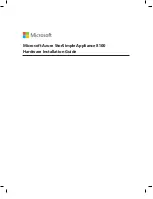
•
The D: drive is for the media file system (SNFS) and database. This allows you to restore the
Windows operating system on the C: drive, yet keep the files on the D: drive intact. You can also
restore the D: drive itself, however your backup and recovery strategy is different for
non-redundant and redundant systems, as follows:
•
On non-redundant servers the media file system program, metadata, and journal files are on
the D: drive. Also the media database program is on the D: drive. Therefore if you ever have
a D: drive fault and you need to recover the data files (metadata, journal, and database), you
can only restore them to the “snap-shot” contained in the most recent disk image you created.
When you do this you restore the program files as well.
•
For redundant K2 SANs, the media file system program is on the D: drive, but the metadata
and journal files are stored on the shared RAID storage. Also the media database program is
on the D: drive, but the database data files are stored on the shared RAID storage. Therefore,
if you ever have a D: drive fault, you can restore the media file system and database programs
from a recovery disk image, and then access the data files (metadata, journal, database) from
the shared RAID storage.
•
The E: drive is for storing a system image of the other partitions. From the E: drive you can
restore images to the C: and D: drives.
When you receive a K2 Media Server from the factory, the machine has a generic image on the E:
drive. The generic image is not specific to the individual machine. It is generic for all machines of
that type. Some K2 Media Servers also have a system-specific image on the E: drive.
You receive a recovery CD with your K2 Media Server. This recovery CD does not contain a disk
image. Rather, the recovery CD is bootable and contains the Acronis True Image software necessary
to create and restore a disk image. This recovery CD is specifically for the Windows server operating
system which runs on the K2 Media Server. It is not for a desktop Windows operating system. Refer
to "K2 Release Notes" for compatible versions of the recovery CD.
After your server is installed, configured, and running in your system environment, you should
create new recovery disk images for the machine to capture settings changed from default. These
“first birthday” images are the baseline recovery image for the machine in its life in your facility.
You should likewise create new recovery disk images after completing any process that changes
system software or data, such as a software upgrade. In this way you retain the ability to restore to
a recent “last known good” state.
For the highest degree of safety, you should create a set of disk image recovery CDs, in addition to
storing disk images on the E: partition. Since system drives are RAID protected, in most failure
cases the disk images on the E: partition will still be accessible. But in the unlikely even of a
catastrophic failure whereby you lose the entire RAID protected system drive, you can use your
disk image recovery CDs to restore the system.
NOTE: Recovery disk images do not back up the media files themselves. You must implement
other mechanisms, such as a redundant storage system or mirrored storage systems, to back up
media files.
Recommended recovery process
The recommended recovery disk image process is summarized in the following steps.
104
K2 SAN Installation and Service Manual
2014 01 27
Managing K2 Software
Summary of Contents for K2 SAN
Page 2: ......
Page 4: ......
Page 28: ...28 K2 SAN Installation and Service Manual 2014 01 27 Preface ...
Page 234: ...234 K2 SAN Installation and Service Manual 2014 01 27 Configuring clients on the K2 SAN ...
Page 239: ...2014 01 27 K2 SAN Installation and Service Manual 239 Operating the K2 SAN ...
Page 248: ...248 K2 SAN Installation and Service Manual 2014 01 27 Operating the K2 SAN ...
Page 346: ...346 K2 SAN Installation and Service Manual 2014 01 27 Index ...
















































